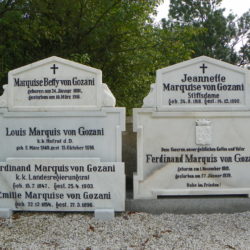
Coat of arms of the Gozani family in Kamnik
KAMNIK, ŽALE CEMETERY
Location of the coat of arms: tombstone
The Gozani (also Gozzani) family may be traced through documents as far back as the fifteenth century. Its members established themselves in Piedmont, in the small town of Casale, where they were granted the title of marquesses and a county with its center at San Giorgio Castle. In the eighteenth century, a branch of the family also settled in the Austrian Empire, in Carniola. The branch was founded by Felice (or Felix) Gozani (1745–1824), who as a younger son was probably destined to join the clergy, but instead he enlisted in the Austrian army at age fifteen. Although he already held the noble title of marquess, he was also granted Austrian nobility in 1817, thenceforth also holding the right to use the Austrian predicate von and consider himself an Austrian nobleman while retaining the title of marquess, even though it did not exist in the Austrian Empire and was therefore void of privilege. Whereas the simple predicate von placed the Gozanis on the lowest rung of the Austrian nobility, they continued to invoke their status of marquesses, which was in fact a noble title of the highest rank (a marquess corresponding to a margrave, or German Markgraf). The Austrian Gozanis also retained the coat of arms that they brought with them from Italy; originally featuring a silver lily and a black man’s head, a silver-red checkered traverse line was also added to it to somehow demonstrate the independence of their (Austrian) line.
In Carniola, they initially led a rather humble life until the mid-nineteenth century, when they inherited a large fortune from their Italian relatives. They used part of the inheritance to purchase the mansion at Volčji Potok, but due to their frivolous spending all their wealth was quickly dissipated. The story about their inheritance has been preserved in several versions to the present day: for example, in Josip Vošnjak’s memoirs (where the family name Gozani is changed to Gazoli) and a historical novel by Jeja Jamar-Legat about the Kaibe House on Škofja Loka’s Town Square.
The inherited Italian fortune was probably also the reason why all Carniolan Gozanis began using the predicate San Giorgio, although unjustifiably so because the predicate could only be borne by the actual owner of the castle in Casale. Nonetheless, it was still in the second half of the nineteenth century that their family name continued to appear with the predicate in sources (e.g., civil registers). Interestingly, the Gozanis in Carniola used the French variant of their title of marquesses, styling themselves “marquis/marquise de Saint Georges.”
The Gozanis’ ties to Volčji Potok are, among other things, demonstrated through the selection of their final resting place in the cemetery in Kamnik, where their family grave has been preserved to date, also featuring the plaques of family members that were still buried in Ljubljana’s old Saint Christopher’s Cemetery and, after it was abandoned, transferred to Kamnik (along with the tombstones of their relatives, the von Gerliczys, which have now disappeared). After the Second World War, the Gozanis left Slovenian territory, leaving their grave abandoned for decades until the neglected plaques were finally repaired in 2012 and restored at the initiative of one of their descendants, Herma Mair from Innsbruck.
Sources:
Rugale, Mariano & Preinfalk, Miha: Blagoslovljeni in prekleti, 2. del: Po sledeh mlajših plemiških rodbin na Slovenskem. Ljubljana: Viharnik, 2010, pp. 24–35.


